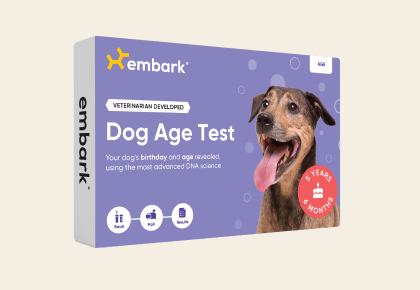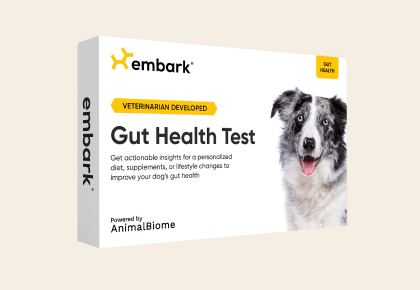At Embark, we often hear from dog lovers that their dog’s breed results don’t match their appearance. How do these DNA surprises happen?
In short, looks can be deceiving. Dogs have more than 20,000 genes. Less than 1% of those genes affect their appearance. Some traits that are associated with a specific breed—like the yellow coat of a Labrador Retriever or the tan points of a Rottweiler—are actually controlled by a handful of genes that can appear in any breed.
Here, we solve five of the most common breed mysteries and uncover a few surprises.
The most surprising breeds in Embark DNA results
1. Chow Chow
Chow Chow is one of the most surprising breed results we hear about at Embark. Chow Chows are known for their fluffy appearance, yet many mixed-breed dogs who share this ancestry don’t have the hallmark look of a Chow Chow. How can this be true?
Though purebred Chow Chows are not especially common today, they were one of the most popular breeds in America in the 1980s and remained popular into the 1990s. Celebrities like Martha Stewart, famous for owning at least five Chow Chows, further popularized the breed.
Today, the mixed-breed descendants of these popular dogs still retain small amounts of Chow Chow DNA, even though they might not look very “Chow-like.” Chow mixes can be hiding in plain sight for several reasons. For starters, their long coat is a recessive trait, which means that even if a Chow mix has one copy of the long-coat variant, they won’t have the same fluffy coat.
Learn more about why so many dogs have Chow Chow ancestry.
2. Poodle
Have you encountered a “secret Poodle”? Perhaps you’ve discovered your mixed-breed dog is surprisingly part Poodle, even though they look nothing like one. Sometimes, a dog’s coat may contain clues about their Poodle ancestry.
Many “scruffy”-looking dogs look like terrier mixes, especially if they’re small in size. But Poodles often have the same “scruffy” traits in their DNA.
The RSPO2 gene gives a dog their furnishings, another name for the beard, mustache, or eyebrows that some dog breeds have. Many Poodles have this “furnishings” gene, but it can be hard to see in purebred Poodles due to other traits. For Poodle mixes, however, the scruffy coat may be easier to see!
Genes like RSPO2 offer clues to how dogs like Bernyk, who looks like a yellow Lab, sometimes turn out to be “secret Poodles.”
3. American Pit Bull Terrier
Known for their short coats, muscular frames, and wedge-shaped heads, the American Pit Bull Terrier (APBT) is one of the most recognizable dog breeds in the world. Despite their distinct appearance, many mixed-breed dogs with APBT ancestry don’t share these traits that the breed is known for.
The mystery becomes clearer when you consider that American Pit Bull Terriers (and related breeds) are among the most common dogs in shelters across America. Because they are so common in general, it’s a natural result for many mixed-breed dogs to have at least some APBT ancestry. This breed also has a wide variety of physical characteristics, which means dogs that are part APBT can look significantly different from each other.
Another clue is in their coats. Some APBT mixes have a dilute (lighter) coat, which is caused by a genetic variant. While the dilute coat trait is often associated with breeds like the Weimaraner, it can show up in APBT mixes, too.
4. Chihuahua
Why do so many mixed-breed dogs have Chihuahua ancestry—even if they don’t look like Chihuahuas?
You might already know what you expect a typical Chihuahua to look like. That expectation might reflect images of Chihuahuas in the media, from fast-food commercials to Hollywood movie stars.
But Chihuahuas are actually a surprisingly diverse breed. According to the American Kennel Club, their coats “come in many colors and patterns, and can be long or short.” This means that Chihuahua DNA corresponds to a variety of looks, so your dog may turn out to be part Chihuahua, even if their coat doesn’t look like a Chihuahua’s.
While Chihuahuas are known for their tiny stature, a dog’s body size is controlled by about 20 different genes. Mixed-breed dogs might inherit body size genes from their larger ancestors—or their smallest ones. That’s why even larger dogs might have some Chihuahua ancestry.
Another reason why Chihuahua is one of the most surprising breeds in Embark breed reveals is because many mixed-breed dogs who have Chihuahua-like traits, such as pointy ears, might also have a wiry coat or other terrier-like features. This can understandably cause surprise when there are no terrier breeds in a dog’s results—but there might be a Chihuahua or “secret Poodle” instead!
5. Village Dog
A village dog result is perhaps the most surprising breed result of them all! To us, it’s also one of the most exciting ones.
You might think that a village dog is just another mixed-breed dog. It may surprise you to hear that this is not true.
Most of the dogs in the world are not purebred or even mixed-breed dogs. They are a unique type of dog called village dogs. Village dogs are free-ranging, free-breeding dogs whose ancestors were indigenous to a geographic area.
What makes village dogs so special? While humans created most dog breeds through careful selective breeding, village dogs adapted to living near human settlements over time (without human intervention). They have a unique origin story that sets them apart from other breeds. We can trace the origin of village dogs all the way back to when dogs and people first became friends.
There are many different types of village dogs. Our cofounders traveled the world studying these special dogs before founding Embark. Today, we test for 60+ types of village dogs—and we’re the only dog DNA company that does.
Learn more about village dogs and why they’re so unique.
Get started with Embark
Find out if there’s a mystery breed hiding in your dog’s DNA with an Embark Dog DNA Test. We test for 400+ breeds, including dingos, coyotes, wolves, and village dogs.
Did your dog have a surprising breed reveal? Let us know by tagging us @embarkvet on Instagram!
With so many surprises in store, there’s more to uncover. Keep reading to see the 10 most common breeds in Embark-tested dogs.
















